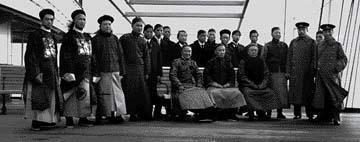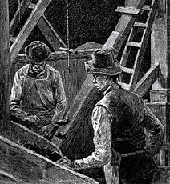By Sharon Boswell
and Lorraine McConaghy
Special to the Times

BOATS OF ALL DESCRIPTIONS --HUNDREDS OF THEM -- ANCHORED IN ELLIOTT BAY to enjoy the spectacle.
Fireworks soared overhead while a brass band entertained the crowds onshore. The din intensified, according
to one local reporter, as "the yells of thousands of people on the docks and the blowing of every steam whistle
for five miles along the waterfront . . . celebrated the glad event and welcomed the Oriental visitor of the East
to the Occident."
Seattle had prepared a royal reception -- bigger than the ceremonies for President Benjamin
Harrison five years before. This visitor, though, was not a politician or an Asian potentate but
a Japanese steamer, the Miike Maru.
The Nippon Yusen Kaisha (the Japanese Mail Steamship Co.)
had recently made Seattle its Pacific Coast terminus, and the Miike Maru was
inaugurating the run. On this late August day in 1896, the city's welcoming committee
enthusiastically proclaimed that Seattle was now the commercial gateway to the Pacific Rim.
For decades the struggling city had hoped to become the leading port of the West Coast,
but railroad magnate James J. Hill had finally brought the dream to life. Hill negotiated an
exclusive arrangement to link the Japanese steamship line to his railroad, the Great Northern,
which had completed its transcontinental connection to Seattle in 1893. To gain advantage over the
rival Northern Pacific, Hill had also promised to build a new terminal, warehouses and grain elevators
along the city's waterfront.
The Gold Rush excitement soon overshadowed Seattle's celebration of these new Asian
ties, but trade with the Orient continued to build during the Klondike years. By 1900, three different
trans-Pacific steamship lines offered regular service to Seattle, bringing in shipments of tea, silk,
ginger and straw matting. These vessels carried back to Asia some manufactured goods, but primarily basic
Northwest commodities: lumber, coal, wheat and metals.
Seattle streetcorner conversations, once focused exclusively on news of the latest gold strike,
now centered on foreign-exchange rates or the effects of proposed tariffs on Asian trade.
At the turn of the century, the editorial page of The Seattle Times confidently predicted
that Seattle's future depended on commerce with the Orient, noting that "The Klondike and Cape Nome, with
all their gold, are mere incidents in the city's progress compared to the great volume of money which will
flow to the one great port of the new Pacific trade."
The Times promoted Seattle as this great port by publishing a souvenir volume,
"Seattle and the Orient," and distributing it throughout Asia and the United States. Detailed descriptions
of the city's businesses and its natural advantages as a Pacific trading partner filled nearly 200 pages.
The engraving below left, taken from Harper's Magazine in 1884,
shows Chinese workers sorting coal at a mine in Renton.
 THE PAPER ALSO SUPPORTED LOBBYING TO OBTAIN GOVERNMENT FUNDING for a ship
canal between Lake Washington and Puget Sound. According to supporters,
the canal would turn the lake into a freshwater basin "with fifty miles of shoreline . . .
for wharves, docks, elevators, warehouses, mills and factories." These facilities could be used
by commercial vessels plying the Far East trade as well as by America's Pacific fleet, a national
priority since the Spanish-American War.
THE PAPER ALSO SUPPORTED LOBBYING TO OBTAIN GOVERNMENT FUNDING for a ship
canal between Lake Washington and Puget Sound. According to supporters,
the canal would turn the lake into a freshwater basin "with fifty miles of shoreline . . .
for wharves, docks, elevators, warehouses, mills and factories." These facilities could be used
by commercial vessels plying the Far East trade as well as by America's Pacific fleet, a national
priority since the Spanish-American War.
Long before the canal was completed, Seattle's trade with Asia flourished.
In 1900 a daily average of 1,200 tons of coal and 5,000 barrels of wheat left Puget Sound for
foreign ports as well as huge quantities of lumber and other wood products. Exports to Japan
were a third greater than to China, but area entrepreneurs hoped to expand Chinese markets,
expecting that country to become the "colossal figure of the Orient."
Asian diplomatic and trade delegations received red-carpet treatment
when they visited the city, and local businessmen such as Chin Gee Hee, an importer and labor
contractor, were regarded as influential community leaders.
Few other Asian immigrants received the respect accorded to wealthy merchants or visiting dignitaries.
Seattle boosters, such as The Times, shared their society's ambivalent attitude toward race,
alternating between fascination and disdain for most of the Chinese and Japanese workers who lived
in the area, but fawning over powerful foreign guests.
Asian laborers were essential to the region's economy, building railroads and working
in the mills, canneries, mines and fields. But especially in precarious economic times, white workers
feared the competition for jobs.
Mistrust and misunderstanding had long marked relations between the races,
and as recently as 1886, bitter anti-Chinese riots in Seattle and Tacoma had escalated into violence.
Fireworks and brass bands celebrated Seattle's enthusiasm for the revenue and prestige of a commanding
position in Pacific Rim trade, but the hoopla did not disguise the community's prejudices
against the Asian laborers who made that trade possible.
Historians Sharon Boswell and Lorraine McConaghy teach at local universities and do research,
writing and oral history. Original newspaper graphics courtesy of the Seattle Public Library.